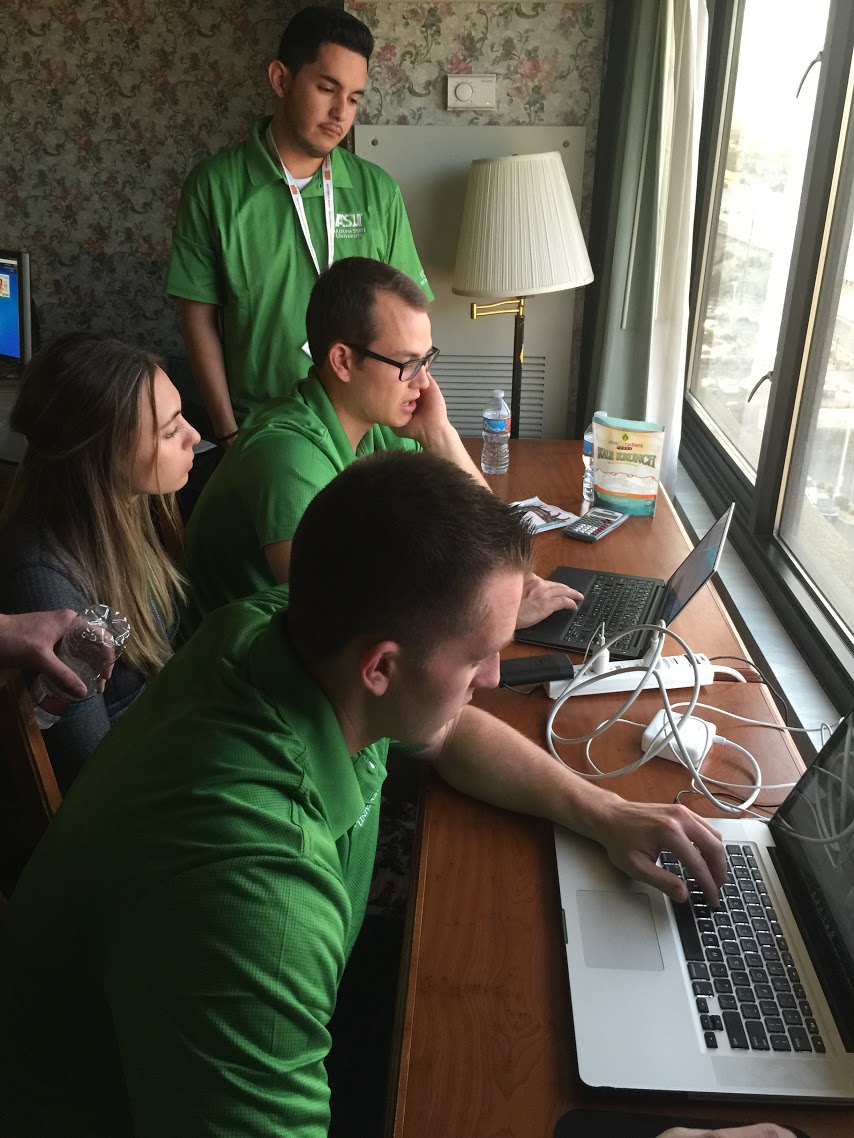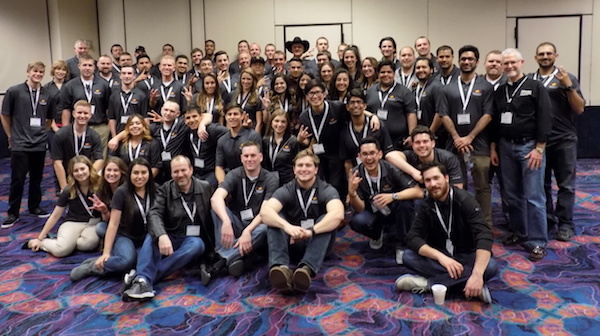
Construction management competition can be career-building experience

Teams in the Reno competition face tight deadlines and tough challenges to find solutions to construction project problems. Pictured at work during the demanding event are ASU students (from foreground to background) Richard Carman, Abby Boaz, Keegan Abele and Christopher Ortega. They were members of one of the Virtual Design and Construction teams.
Photographer: Whitney Hatfield/ASU
Four frenzied days — and nights — of facing brain-straining problems.
Tight deadlines. Little sleep.
Standing before panels of experts charged with rendering tough judgment on your work.
Matching skills against determined peers in a contest in which only a small fraction of the players can grab a trophy.
And yet the students subjected to the rigors of what is known as the Reno competition at the Associated Schools of Construction (ASC) annual regional conference in Nevada are always thrilled to be there.
“It is an amazing event that all construction and design students should experience,” said Tom Fyffe, who will graduate from Arizona State University this spring with a construction management degree. He has participated in four regional ASC student competitions.
“It has been the highlight of my time at ASU,” said Daisy Herrera, a senior in construction management and a veteran of six ASC student competitions.

ASU’s Ira A. Fulton Schools of Engineering brought a large contingent of its construction management and construction engineering students to the recent Associated Schools of Construction Reno competition. Photographer: Whitney Hatfield/ASU
Solving real-word construction problems
Fyffe and Herrera were among 77 students in ASU’s Ira A. Fulton Schools of Engineering to participate in the recent ASC Reno competition.
Construction management and construction engineering majors in the Del E. Webb School of Construction and the School of Sustainable Engineering and the Built Environment were joined at the event by more than 1,300 fellow students from close to 50 college and university construction schools.
It’s a hectic environment in which the competitive atmosphere can be physically and emotionally intense, but learning to endure the ordeal is big part of what makes it worthwhile for students, said construction management lecturer Aaron Cohen, the ASU team’s faculty advisor.
“I can’t think of a better situation for students to get an opportunity to work together to come up with solutions to real-world construction problems,” Fyffe said. “You get to apply all the skill sets you’re learning in school and receive exposure to what the job pressures can be like in the construction industry.”
Each school can enter teams — of typically six or seven students — in any of 12 problem categories. This year ASU had four teams entered in regional categories and seven teams in categories open to teams from all ASC regions across the country.
Multiple management and planning challenges
Teams are given problems from actual construction projects. Students must devise solutions that include plans and strategies for project scheduling, labor coordination, work site safety, cost estimation and sustainable design, among other things.
They then have to present their solutions to judges, many of whom work with companies that were involved in those construction projects, and who know how the array of problems were remedied.
Herrera’s team, for example, was given an assignment based on the $4 billion-plus Transbay Transit Center construction project in San Francisco.
The project involved replacing the former Transbay Terminal with a new one to serve as the hub for 11 various transportation systems.
That meant extending the Caltrain railway and the California High Speed Rail underground line from Caltrain’s current terminus, and creating a neighborhood environment by building a park atop the terminal’s 5.4-mile green roof.
The team had to deal with multiple issues, including socioeconomic impacts, water-use and reuse efficiency, the heat island effect, indoor building materials, and sizing and locating of a photovoltaic array for a solar energy system. The team also did a life-cycle analysis for the energy system, as well as a cost-benefit analysis, and developed an estimate for project construction costs.
Creating camaraderie and finding jobs
Despite the intensity of the task, Herrera said, it was all great fun — and rewarding both personally and professionally.
“I created strong bonds with many of my peers,” she said. “I would be excited if I ever get the opportunity to work with them again.”
Fyffe had similar impressions.
“The most fun is the interaction with other students. There’s a family-like environment,” he said. “You’re able to develop long-term professional and personal relationship that are invaluable, and that otherwise you might not have had the chance to do.”
And after the competition, there’s the job fair, offering oppportunities to meet with representatives of a plethora of potential employers network informally with industry leaders.
It’s what made the competition “the best thing that could have happened to me,” Herrera said. “I scored my dream job there.”
Both she and Fyffe have accepted positions with PCL Construction, an international group of independent construction companies. Their participation in previous ASC competitions helped them earn internships with the company that led to the offers of full-time employment.
In jobs they will begin after graduation in May, Fyffe will work in PCL’s water infrastructure group in Phoenix and Herrera will be with the building division based in Los Angeles.
Herrera likely will contribute to work on high-profile projects such as the Harry Potter-themed attraction at Universal Studios in Hollywood, the renovation of the Jules Stein Eye Institute at the University of California, Los Angeles (where LASIK eye surgery was developed) and the new Los Angeles Football Club soccer stadium.
“I can’t stress enough to other students that the ASC competitions are a huge deal in our industry,” she said, “and it is definitely something worth giving a shot.”
Students responsible for making event successful
Team advisor Cohen points out that getting to the competition is a major accomplishment in itself for students.
“This is a student-run endeavor. They organize their own teams, including reaching out to students in other programs for needed skill sets, like architecture. They find their own faculty and industry coaches, they complete their own preparations for the competition and they go out and raise funds from industry” to finance the trip, he explained.
It typically costs from $4,000 to $5,000 — including airfare and lodging — to send a team to the event, but the payoff for fund-raising efforts goes beyond getting money to participate in the competition.
“It has the added benefit of providing students with more opportunities to engage with industry supporters and have meaningful interactions with people from many of the companies that recruit students from our construction programs,” Cohen said.
Students interested in getting involved in future Reno competitions should send inquiries requesting information to [email protected] or [email protected]
By Joe Kullman



































